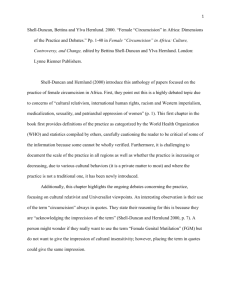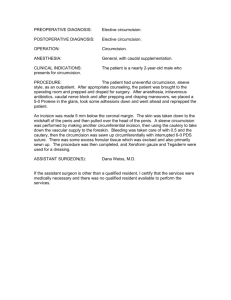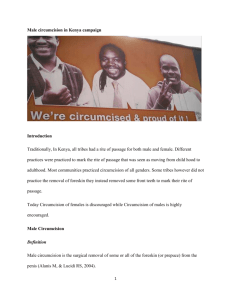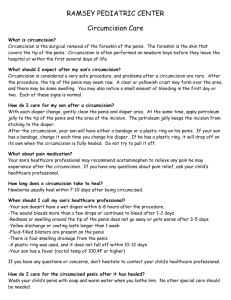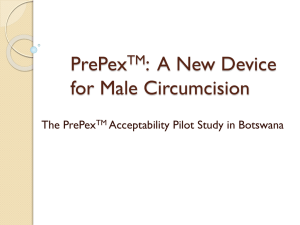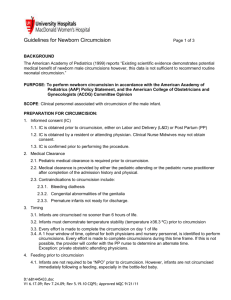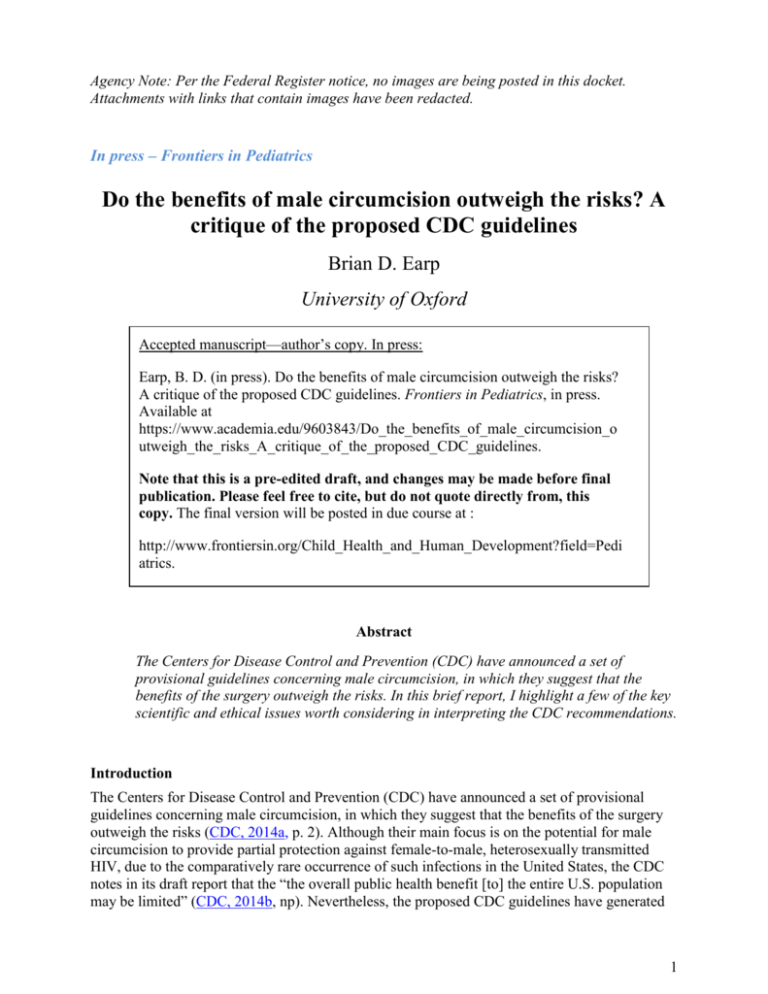
Agency Note: Per the Federal Register notice, no images are being posted in this docket.
Attachments with links that contain images have been redacted.
In press – Frontiers in Pediatrics
Do the benefits of male circumcision outweigh the risks? A
critique of the proposed CDC guidelines
Brian D. Earp
University of Oxford
Accepted manuscript—author’s copy. In press:
Earp, B. D. (in press). Do the benefits of male circumcision outweigh the risks?
A critique of the proposed CDC guidelines. Frontiers in Pediatrics, in press.
Available at
https://www.academia.edu/9603843/Do_the_benefits_of_male_circumcision_o
utweigh_the_risks_A_critique_of_the_proposed_CDC_guidelines.
Note that this is a pre-edited draft, and changes may be made before final
publication. Please feel free to cite, but do not quote directly from, this
copy. The final version will be posted in due course at :
http://www.frontiersin.org/Child_Health_and_Human_Development?field=Pedi
atrics.
Abstract
The Centers for Disease Control and Prevention (CDC) have announced a set of
provisional guidelines concerning male circumcision, in which they suggest that the
benefits of the surgery outweigh the risks. In this brief report, I highlight a few of the key
scientific and ethical issues worth considering in interpreting the CDC recommendations.
Introduction
The Centers for Disease Control and Prevention (CDC) have announced a set of provisional
guidelines concerning male circumcision, in which they suggest that the benefits of the surgery
outweigh the risks (CDC, 2014a, p. 2). Although their main focus is on the potential for male
circumcision to provide partial protection against female-to-male, heterosexually transmitted
HIV, due to the comparatively rare occurrence of such infections in the United States, the CDC
notes in its draft report that the “the overall public health benefit [to] the entire U.S. population
may be limited” (CDC, 2014b, np). Nevertheless, the proposed CDC guidelines have generated
1
significant interest among public health professionals, as well as among the population at large.
In this brief report, I highlight a few of the key scientific and ethical issues worth considering in
interpreting these new recommendations.
Following the AAP
First, the CDC appears largely to be following the American Academy of Pediatrics (AAP),
whose 2012 policy statement and technical report have been subjected to numerous international
critiques (e.g., Frisch et al., 2013, Svoboda & Van Howe, 2013; Garber, 2013; Hartmann, 2012;
Lawson, 2012; Booker, 2012; Bewley & Stranjord, 2012; Guest, 2012; Androus, 2013; Earp &
Darby, 2014). While these critiques are not necessarily definitive, they do raise a number of
concerns about the manner in which the AAP, and by extension, the CDC, conducted its analysis
of the available literature on male circumcision, and presented its findings to the public.1
Among other issues, critics have pointed out that the bulk of the data used to justify the
AAP/CDC policies was derived from studies of adult circumcision carried out in sub-Saharan
Africa—a geographic region whose epidemiological environments and patterns of disease
transmission are dissimilar, along numerous dimensions, to those elsewhere in the world (see,
e.g., Lyons, 2013, Garenne et al., 2013, Sullivan et al., 2007). This is important, because the
spread of disease, including sexually transmitted infections, is determined much more by sociobehavioral and situational factors than by strictly anatomical-biological factors, such as the
presence or absence of a foreskin (see, e.g., Ramos et al., 2009, Darby, 2014). In other words, the
apparent findings from these studies cannot be simply mapped on to non-analogous public health
environments (Sullivan et al., 2007), nor to circumcisions performed earlier in life, i.e., before an
age of sexual debut (see, e.g., Earp, 2015). As Bossio et al. (2014) argue in a recent
comprehensive review, not referenced by the CDC, “At present … the majority of the literature
on circumcision is based on research that is not necessarily applicable to North American
populations” (p. 2847).
The CDC acknowledges this "translation" problem: “Much of the data related to HIV and STI
prevention are from randomized clinical trials (RCTs) conducted among men in sub-Saharan
Africa in regions with high rates of heterosexually acquired HIV infection. In the United States
[by contrast] the prevalence of HIV and lifetime risk of HIV infection are generally much lower
than [in] sub-Saharan Africa. Also, most new HIV infections in the United States are attributed
to male-male sex, a population for whom male circumcision has not been proven to reduce the
risk of HIV acquisition” (CDC, 2014a, p. 1).
Benefit vs. risk
In addition to such empirical limitations, the proposed CDC guidelines exhibit conceptual and
ethical limitations as well. Conceptually, the CDC relies on an inappropriate construal of risk in
its benefit vs. risk analysis, since it appears to interpret “risk” as referring (primarily or
exclusively) to the “risk of surgical complications.” To begin with, the actual incidence of
surgical complications is not known, due to the poor quality of the available data on this question
as well as conflicting definitions of (and ways of measuring) “complications” (see AAP, 2012).
Thus, as Garber (2013) has noted, “it is inconceivable that the AAP [and by extension, the CDC]
could have objectively concluded that the benefits of the procedure outweigh the risks when the
‘true incidence of complications’ isn’t known” (p. 69).
1
See Earp (in press), for a discussion of the proper role of scientific organizations in shaping public understanding.
2
Even if this figure were known, however, the CDC test would still be ill-conceived. This is
because the standard heuristic for evaluating non-therapeutic surgery (i.e., surgery performed in
the absence of disease or deformity) is not benefit vs. “risk of surgical complications” but rather
benefit vs. risk of harm (for an in-depth discussion, see Darby, in press). In this case, at least one
relevant harm would be the inherent loss of a healthy, functional, and erotogenic penile structure
(Cold & Taylor, 1999; Taylor et al., 1996), amounting to approximately 30-50 square
centimeters of densely innervated, elastic genital tissue in the adult organ (see Earp, 2015; Earp
& Darby, 2014; Werker, 1998). To its discredit, the CDC nowhere in its proposed guidelines
mentions, much less explores in any detail, the actual anatomy or functions of the penile
prepuce—i.e., the part of the penis that is removed by circumcision (see Guest, 2012). As Fleiss
and Hodges (2002) ask, “How can parents make a rational decision about circumcision when
they are told nothing about the part that will be cut off?” (p. xii). For a point of comparison,
imagine a report by the CDC discussing the health benefits of prophylactic mastectomy, in which
the only implied harms of the procedure were “surgical complications,” and in which the
anatomy and functions of the breasts were nowhere described.
Harm
Most basically, the CDC’s approach runs counter to the conventional bioethical (and legal) view
that unnecessary surgeries, and especially those that remove non-diseased, functional tissue from
an individual without his consent, are in and of themselves harmful. As a California Appeals
Court recently held (see Adler, 2012), “[I]t seems self-evident that unnecessary surgery is
injurious and causes harm to a patient. Even if a surgery is executed flawlessly, if the surgery
were unnecessary, the surgery in and of itself constitutes harm” (p. 496).
The only other potential harm that the CDC appears to have entertained is the possibility of
diminished sexual experience, finding that: “Adult men who undergo circumcision generally
report minimal or no change in sexual satisfaction or function” (CDC, 2014a, p. 7). However, the
CDC’s appraisal of the literature on this point is as superficial as it is selective.2 As Bossio et al.
(2014) noted in their recent review: “Adverse self-reported outcomes associated with foreskin
removal in adulthood include impaired erectile functioning, orgasm difficulties, decreased
masturbatory functioning (loss in pleasure and increase in difficulty), an increase in penile pain,
a loss of penile sensitivity with age, and lower subjective ratings of penile sensitivity” (p. 2853,
internal references omitted). While “other studies have found no significant differences in selfreported sexual functioning following adult circumcision” (ibid.), it must be remembered that a
lack of statistical significance does not entail a lack of underlying effect (Aberson, 2002). For
example, in one of the studies cited by the CDC, “several questions were too vague to capture
possible differences between circumcised and not-yet circumcised participants [such that] nondifferential misclassification of sexual [outcomes] probably favoured the null hypothesis of no
difference, whether an association was truly present or not” (Frisch, 2012, p. 313).
Finally, the CDC ignores the fact that any sensation in the foreskin itself is necessarily eliminated
by circumcision, as are any sexually-relevant (e.g., masturbatory) functions that require its
2
In the 61-page technical report which forms the basis for its proposed recommendations, the CDC (2013) dedicates a total of
four sentences to the possible effects of circumcision on sexual sensation, function, and/or satisfaction. Moreover, it fails to
reference, much less discuss, several well-known studies providing evidence of negative effects of circumcision on sexuality
(e.g., Kim & Pang, 2007; Frisch et al. 2011; Dias et al., 2014; Bronselaer et al., 2013), including some that were available within
the period of review. Instead, the CDC relies on other studies purporting to show a lack of adverse outcomes, without citing any
of the published critiques of those studies. For a recent, comprehensive, and nuanced discussion of the available literature on the
various sexual (and other) effects of circumcision, see Bossio et al., 2014.
3
manipulation. As I have argued elsewhere: “To say that circumcision has ‘little or no effect’ on
sexual experience … is to adopt an extremely narrow conception of that term” (Earp, 2015).
More generally, studies of adult male circumcision often lack adequate long-term follow-up, and
assess only a limited range of sexual outcome variables (Bossio et al., 2014; Frisch & Simonsen,
2015; Earp, 2015).
Risk and risk perception
In addition to its inadequate conception of risk, the CDC portrays the risks that it does consider
in a potentially misleading manner. This is because it describes the “benefits of male
circumcision [in terms of] relative-risk reductions (e.g., a 50% reduction from a 2% risk of an
STI to a 1% risk), whereas any associated harm is expressed as an absolute risk (e.g., a 2-4% risk
of adverse events)” (CDC, 2014a, p. 2). In other words, the purported benefits of circumcision
are described in “big” numbers (that is, figures whose values may be quite large despite being
derived from small absolute percentages; see Earp & Darby, 2014), whereas the potential harms
are described in “small” numbers (i.e., percentages expressing absolute risk). This may have the
effect of inflating the perceived likelihood and/or magnitude of the potential benefits of
circumcision, and deflating the drawbacks and harms, especially in the minds of those who are
unversed in medical statistics (see, e.g., Slovic, 2000; Williams, 2013). Since this is likely to
include the very individuals whom the CDC suggests should undergo “counseling” about male
circumcision, such differential risk-description poses a threat to the ethical validity of obtaining
their informed consent (see generally, Ingelfinger, 1972; Hester, 2004; Jones, 2013).3
This is not a trivial concern. As Hoffmann and Del Mar (2014) have shown, patients—in
general—already tend to overestimate the benefits of proposed medical interventions, and
already tend to underestimate the harms. Thus, unless patients (or parents) clearly understand
that their (or their child’s) absolute risk of, e.g., heterosexually acquired HIV infection in the
United States is very low—indeed nearly zero before an age of sexual debut—the relative risk
reduction figures presented by the CDC could give the wrong impression.
Health benefits? Taking into account gender and ethics
On the question of health benefits, suppose it could be shown that removing the labia majora of
infant girls reduced their risk of acquiring a urinary tract infection (since there would be fewer
folds of moist genital tissue in which bacteria could find a home), as well as, say, cancers of the
vulva—or even HIV (Stallings & Karugendo, 2005). It is not biologically implausible. In fact, in
countries in which female “circumcision” is culturally normative, it is often said to confer a
range of such benefits, including “a lower risk of vaginal cancer … less nervous anxiety, fewer
infections from microbes gathering under the hood of the clitoris, and protection against herpes
and genital ulcers” (Svoboda & Darby, 2008, p. 258). In addition, female “circumcision” in such
countries is often described as "more hygienic" as well as more aesthetically pleasing (LightfootKlein, 1997).
3
Related to this worry, it is important that patients (or parents) not mistake the CDC’s recommendation about counseling
regarding circumcision—a process whose conclusion for any individual patient may very well be that it should not be done—for
a recommendation about circumcision generally, i.e., that it should be performed as a routine precaution. But as patients (or
parents) might reasonably ask, “Why would the CDC both recommend that I be routinely counseled about the benefits and risks
of circumcision, as well as strongly suggest that the former outweigh the latter, unless it ‘wanted’ me (or my son) to be
circumcised?” Such mixed messaging further reduces the possibility of obtaining (truly) informed consent, whether from the
patient or from his putative proxy.
4
Now, it is usually not recognized that female "circumcision" falls on a spectrum; that some forms
of it are less invasive than male circumcision (including several forms that do not involve
modification of the clitoris); and that it is sometimes done for reasons other than (attempted)
control of sexuality (Androus, 2004; Shell-Duncan & Hernlund, 2000; Abdulcadir, 2012; Davis,
2001; Earp, 2014; Earp, 2013). Nevertheless, it is actually illegal in Western countries to conduct
the very research by which such "health benefits" could be “discovered” in the first place. This is
because non-therapeutic surgeries performed on the genitals of healthy girls—no matter how
slight, nor under what material conditions—are deemed to be impermissible mutilations in
Western law (Davis, 2001).
Presumably, this is due to concerns about respect for sexual self-determination, a desire to
protect children’s (future) autonomy (see Maslen et al., 2014; Darby, 2013; Svoboda, 2013), and
a recognition of their basic moral and legal rights to bodily integrity and to security of the person
(see, e.g., Ungar-Sargon, 2013; Merkel and Putzke, 2013; Schüklenk, 2012). Moreover, since
there are more effective, but much less invasive, ways of preventing and/or treating most of the
diseases to which the external female genitalia may sometimes fall prey—such as the use of soap
and water for simple hygiene, the adoption of safe sex practices, and the administration of
antibiotics, if required—it seems reasonable to argue that pre-emptive surgery toward the same
ends would fail the test of proportionality (Hermerén, 2012).
Taken together, these considerations suggest that little girls should be free to grow up with their
genitals intact, and to decide, at an age of understanding, whether they would like to undergo
permanent alterations to their "private parts," and if so, for what reasons (and what kind). The
same considerations apply equally to boys (DeLaet, 2009; Johnson, 2010; Svoboda & Darby,
2008; Svoboda, 2013; Fox & Thomson, 2005; Earp, 2014; see also Shweder, 2013 and Solomon
& Noll, 2007 for further discussion).
Timing
With respect to timing, the CDC (2014a) states, “Neonatal male circumcision is, safer, [sic] and
heals more rapidly than circumcision performed on older boys [and] men, and is less expensive”
(p. 4). There are two points to consider here. First, as Svoboda and Van Howe (2014) have
argued: “complications may certainly be better documented for adults, who have the knowledge
and wherewithal to complain if something goes wrong; but there is no consistent evidence that
properly-performed adult circumcision is actually riskier.”4 Second, “It is true that it can be more
costly, but only if proper pain control is used: general anaesthesia is contra-indicated in infants,
meaning that the surgery is performed either with no pain control or with sub-optimal pain
control, driving down costs at the expense of humane treatment” (Svoboda & Van Howe, 2014;
see also Frisch & Simonsen, 2015).
A further concern has to do with risk interpretation. According to even proponents of (adult)
circumcision, such as Gray et al. (2007), the absolute likelihood of clinically significant, nonresolvable surgical complications associated with the surgery is low, regardless of the age at
which it is performed. Thus, even if one were to grant that there is a relative risk reduction in the
4
Emphasis added. As they go on to state: “Only three studies have directly compared the complication rates of infant and later
circumcision. One found no difference; another found a significantly greater rate following infant circumcision; and a third found
the opposite when using a Plastibell device” (np, internal refs omitted). The issue of direct comparison is important. This is
because the claim that infant circumcision has fewer risks compared to later (i.e., adult) circumcision is often grounded in appeals
to retrospective comparisons of different studies (or data sets), conducted by different researchers, with results drawn from
discordant populations. Thus they do not adequately control for such variables as the skill of the practitioner, the specific
device(s) used, the sterility of the environment, and so on.
5
incidence of adverse events—over and above the loss of functional tissue—this consideration
would not be morally decisive.
To see why this is the case, consider the hypothesis that any number of surgeries might be
(statistically) ‘safer’ if carried out in the neonatal period. The prior question, however, is whether
the surgery itself is ethically sound. For example, imagine that it could be shown that removing a
child's earlobes for non-therapeutic reasons was ‘less risky’ if it were done to an infant.
Nevertheless, from a moral perspective, such an intervention would not be allowed.
(Sommerville, 2004; Merkel & Putzke, 2013).
The CDC (2013) seems to recognize such concerns. As it states in its unpublished background
report: “Delaying male circumcision until adolescence or adulthood obviates concerns about
violation of autonomy” (p. 39), and therefore any “disadvantages associated with [such a
deferral] would be ethically compensated to some extent by the respect for the [bodily] integrity
and autonomy of the individual” (pp. 39-40).
Conclusion
As Murphy (1997) has argued: “Biomedical research and its social applications are almost
always worthy of sustained critical scrutiny” (p. 11). In this case, it is not altogether clear that a
minor reduction in the (absolute) risk of certain infections or diseases—whose prevalence in
developed nations is generally low, and whose occurrence can typically be avoided by other, less
injurious means—is worth the “trade-off” of losing a part of one’s penis. What is certain,
however, is that the answer to this question is likely to be highly subjective, and to depend upon
numerous, unpredictable, and ultimately personal factors (see Darby, in press). Therefore, it
should be up to the affected individual himself (or indeed herself, in analogous circumstances) to
decide about permanent genital-modification surgeries at such a time as he or she can
meaningfully factor in his or her own preferences and values (see Maslen et al. 2014; Earp, 2014;
Ungar-Sargon, 2013).5 Circumcision before an age of consent is not a desirable health-promotion
strategy, given more effective—and less ethically problematic—alternatives.
About the author
Brian D. Earp is a Research Fellow in Science and Ethics at the University of Oxford. He holds
degrees from Yale, Oxford, and Cambridge universities, including an M.Phil. degree in the
history, philosophy, and sociology of science and medicine, focusing on male and female genital
surgeries. Brian has served as a Guest Editor for the Journal of Medical Ethics, editing a special
issue on the topic of childhood circumcision, and has published widely in the leading journals in
his field.
5
To elaborate: by suggesting that the benefits of circumcision outweigh the risks (as opposed to merely presenting what is
known about the potential benefits and risks, such as their type, their likelihood under various conditions, etc., without presuming
to know how these factors should be balanced against one another), the CDC makes a number of value-laden (see Hofmann,
2002), and, as some would argue, potentially culturally biased (see Frisch et al., 2013), ethical assumptions (see Savulescu, 2015,
p. 30). For example, the CDC assumes that the foreskin itself has little or no value, which is a relatively uncommon view outside
of circumcising cultures; it assumes, as I have argued, that the (unknown) risk of surgical complications is the only, or at least the
main, morally-relevant cost to circumcision, etc. But given the contentious nature of non-therapeutic circumcision, from both a
moral and scientific perspective (see Collier, 2012), as well wide variance, both culturally and individually, with respect to norms
about intact vs. modified genitals, it seems reasonable to argue that it is not the CDC that should be making such idiosyncratic
ethical valuations (see Earp, in press), but rather the individual who will be affected by the surgery (see Darby, in press; Earp,
2014; Earp, 2015).
6
References
Abdulcadir, J., Ahmadu, F. S., Catania, L., Essén, B., Gruenbaum, E., Johnsdotter, S., ... &
Shweder, R. A. (2012). Seven things to know about female genital surgeries in Africa. The
Hastings Center Report, 42(6), 19-27.
Aberson, C. (2002). Interpreting null results: improving presentation and conclusions with
confidence intervals. Journal of Articles in Support of the Null Hypothesis, 1(3), 36-42.
Adler, P. W. (2012). Is circumcision legal? Richmond Journal of Law and the Public Interest, 16,
439-483.
American Academy of Pediatrics Task Force on Circumcision. (2012). Male circumcision.
Pediatrics, 130(3), e756-85.
Androus, Z. T. (2013). Critiquing circumcision: in search of a new paradigm for conceptualizing
genital modification. Global Discourse, 3(2), 266-280.
Androus, Z. T. (2004). The United States, FGM, and global rights to bodily integrity. Paper
presented at The Rothermere American Institute Conference: The United States and Global
Human Rights. University of Oxford. Available at:
http://www.zacharyandrous.com/The%20US%20FGM%20and%20Global%20HR.pdf.
Bewley S., & Stranjord, S. (2012). Being honest about medical involvement that contravenes
"first of all, do no harm.” Pediatrics. E-letter. Available at:
http://pediatrics.aappublications.org/content/130/3/585.short/reply#pediatrics_el_55563.
Booker, C. S. (2012). Re: Technical report on male circumcision. Pediatrics. E-letter. Available
at http://pediatrics.aappublications.org/content/130/3/e756.full/reply#pediatrics_el_54322.
Bossio, J. A., Pukall, C. F., & Steele, S. (2014). A review of the current state of the male
circumcision literature. The Journal of Sexual Medicine, 11(12), 2847–2864.
Bronselaer, G. A., Schober, J. M., Meyer‐ Bahlburg, H. F., T'sjoen, G., Vlietinck, R., &
Hoebeke, P. B. (2013). Male circumcision decreases penile sensitivity as measured in a large
cohort. BJU International, 111(5), 820-827.
CDC (2014a). Recommendations for providers counseling male patients and parents regarding
male circumcision and the prevention of HIV infection, STIs, and other health outcomes.
Available at: http://www.regulations.gov/#!documentDetail;D=CDC-2014-0012-0003.
CDC (2014b). Draft CDC recommendations for providers counseling male patients and parents
regarding male circumcision and the prevention of HIV infection, STIs, and other health
outcomes. Available at: http://www.cdc.gov/nchhstp/newsroom/docs/MC-factsheet-508.pdf.
CDC (2013). Division of HIV/AIDS Prevention, Centers for Disease Control and Prevention.
Background, methods, and synthesis of scientific information used to inform the draft:
recommendations for providers counseling male patients and parents regarding elective male
circumcision and the prevention of HIV infection and other adverse health outcomes.
Unpublished. Available at http://arclaw.org/sites/default/files/CDC-2014-0012-0002.pdf.
7
Cold, C. J., & Taylor, J. R. (1999). The prepuce. BJU International, 83(S1), 34-44.
Collier, R. (2012). Ugly, messy and nasty debate surrounds circumcision. Canadian Medical
Association Journal, 184(1), E25-E26.
Darby, R. J. (in press). Risks, benefits, complications and harms: issues in the current debate on
non-therapeutic circumcision. Kennedy Institute of Ethics Journal, in press.
Darby, R. J. (2013). The child's right to an open future: is the principle applicable to nontherapeutic circumcision? Journal of Medical Ethics, 39(7), 463-8.
Darby, R. J. (2014). Syphilis 1855 and HIV-AIDS 2007: Historical reflections on the tendency to
blame human anatomy for the action of micro-organisms. Global Public Health, (ahead-of-print),
1-16.
Davis, D. S. (2001). Male and female genital alteration: a collision course with the law. Health
Matrix, 11, 487-570.
DeLaet, D. L. (2009). Framing male circumcision as a human rights issue? Contributions to the
debate over the universality of human rights. Journal of Human Rights, 8(4), 405-426.
Dias, J., Freitas, R., Amorim, R., Espiridião, P., Xambre, L., & Ferraz, L. (2014). Adult
circumcision and male sexual health: a retrospective analysis. Andrologia, 46(5), 459-464.
Earp, B. D. (in press). “Legitimate rape,” moral coherence, and degrees of sexual harm. Think, in
press. Available at:
https://www.academia.edu/9014885/_Legitimate_rape_moral_coherence_and_degrees_of_sexua
l_harm.
Earp, B. D. (2015). Sex and circumcision. American Journal of Bioethics, in press. Available at
https://www.academia.edu/9404847/Sex_and_circumcision.
Earp, B. D. (2014). Female genital mutilation (FGM) and male circumcision: should there be a
separate ethical discourse? Practical Ethics. University of Oxford. Available at:
https://www.academia.edu/8817976/Female_genital_mutilation_FGM_and_male_circumcision_
Should_there_be_a_separate_ethical_discourse.
Earp, B. D. (2013). The ethics of infant male circumcision. Journal of Medical Ethics 39(1):
416-417.
Earp, B. D., & Darby, R. J. (2014). Does science support infant circumcision? A skeptical reply
to Brian Morris. The Skeptic. E-pub ahead of print. Available at
https://www.academia.edu/9872471/Does_science_support_infant_circumcision.
Fleiss, P. M., & Hodges, F. M. (2002). What your doctor may not tell you about circumcision.
Hachette Digital, Inc.
Fox, M., & Thomson, M. (2005). A covenant with the status quo? Male circumcision and the
new BMA guidance to doctors. Journal of Medical Ethics, 31(8), 463-469.
8
Frisch, M. (2012). Author's response to: does sexual function survey in Denmark offer any
support for male circumcision having an adverse effect? International Journal of Epidemiology,
41(1), 312-314.
Frisch, M., Aigrain, Y., Barauskas, V., Bjarnason, R., Boddy, S. A., Czauderna, P., ... & Wijnen,
R. (2013). Cultural bias in the AAP’s 2012 Technical Report and Policy Statement on male
circumcision. Pediatrics, 131(4), 796-800.
Frisch, M., Lindholm, M., & Grønbæk, M. (2011). Male circumcision and sexual function in
men and women: a survey-based, cross-sectional study in Denmark. International Journal of
Epidemiology, 40(5), 1367-1381.
Frisch, M., & Simonsen, J. (2015). Ritual circumcision and risk of autism spectrum disorder in
0- to 9-year-old boys: national cohort study in Denmark. Journal of the Royal Society of
Medicine, in press.
Garber, S. T. (2013). The circular cut: problematizing the longevity of civilization’s most
aggressively defended amputation. Unpublished manuscript, Department of Philosophy,
Wesleyan University, Middletown, CT, USA.
Garenne, M., Giami, A., & Perrey, C. (2013). Male circumcision and HIV control in Africa:
Questioning scientific evidence and the decision-making process. In T. Tamara Giles-Vernick &
J. L. A. Webb Jr. (Eds.), Global health in Africa: Historical perspectives on disease control.
Athens, OH: Ohio University Press.
Gray, R. H., Kigozi, G., Serwadda, D., Makumbi, F., Watya, S., Nalugoda, F., ... & Wawer, M. J.
(2007). Male circumcision for HIV prevention in men in Rakai, Uganda: a randomised trial. The
Lancet, 369(9562), 657-666.
Guest, C. (2012). Revised male infant circumcision policy: a disservice to Americans. Pediatrics.
E-letter. Available at
http://pediatrics.aappublications.org/content/130/3/585.short/reply#pediatrics_el_55563.
Hartmann, W. (2012). Expert statement: Dr med. Wolfram Hartmann, President of
"Berufsverband der Kinder- und Jugendärzte" [German Pediatric Society] for the hearing on the
26th of November 2012 concerning the drafting of a federal government bill. Berufsverband der
Kinder- und Jugendärtze (BVKJ). German original available at http://www.kinderaerzte-imnetz.de/bvkj/kinpopup/psfile/pdf/70/121126_Ste50aa5e211e6a6.pdf; English translation
available at: http://www.intactamerica.org/german_pediatrics_statement.
Hermerén, G. (2012). The principle of proportionality revisited: interpretations and applications.
Medicine, Health Care and Philosophy, 15(4), 373-382.
Hester, J. D. (2004). Intersex(es) and informed consent: how physicians' rhetoric constrains
choice. Theoretical Medicine and Bioethics, 25(1), 21-49.
Hoffmann, T., & Del Mar, C. (2014). Patients’ expectations of the benefits and harms of
treatments, screening, and tests: a systematic review. JAMA Internal Medicine, online first ahead
of print, doi:10.1001/jamainternmed.2014.6016.
9
Hofmann, B. (2001). On the value-ladenness of technology in medicine. Medicine, Health Care
and Philosophy, 4(3), 335-345.
Ingelfinger, F. J. (1972). Informed (but uneducated) consent. The New England Journal of
Medicine, 287(9), 465-466.
Johnson, M. (2010). Male genital mutilation: beyond the tolerable? Ethnicities, 10(2), 181-207.
Jones, C. (2013). The facade of inevitibility: agency, risk, and the American Academy of
Pediatrics' 2012 Technical Report on Male Circumcision. Unpublished manuscript. Iowa State
University. Available at
http://lib.dr.iastate.edu/cgi/viewcontent.cgi?article=4190&context=etd&seiredir=1&referer=http%3A%2F%2Fscholar.google.co.uk%2Fscholar%3Fhl%3Den%26q%3Drhe
torical%2Banalysis%2Bof%2Bthe%2BAAP%2B2012%2Bpolicy%2Bon%2Binfant%2Bmale%2
Bcircumcision%26btnG%3D%26as_sdt%3D1%252C48%26as_sdtp%3D#search=%22rhetorical
%20analysis%20AAP%202012%20policy%20infant%20male%20circumcision%22.
Kim, D., & Pang, M. G. (2007). The effect of male circumcision on sexuality. BJU International,
99(3), 619-622.
Lawson, C. R., (2012). Re: AAP circumcision policy statement and technical report. Pediatrics.
E-letter. Available at
http://pediatrics.aappublications.org/content/130/3/e756.full/reply#pediatrics_el_54322
Lightfoot-Klein, H. (1997). Similarities in attitudes and misconceptions about male and female
sexual mutilations. In Sexual Mutilations (pp. 131-135). Springer US.
Lyons, B. (2013). Male infant circumcision as a ‘HIV vaccine’. Public Health Ethics, 6(1), 90103.
Maslen, H., Earp, B. D., Cohen Kadosh, R., & Savulescu, J. (2014). Brain stimulation for
treatment and enhancement in children: An ethical analysis. Frontiers in Human Neuroscience, 8,
953.
Merkel, R., & Putzke, H. (2013). After Cologne: male circumcision and the law. Parental right,
religious liberty or criminal assault? Journal of Medical Ethics 39(7), 444-449.
Murphy, T. F. (1997). Gay science: The ethics of sexual orientation research. New York:
Columbia University Press.
Ramos, R., Ferreira-Pinto, J. B., Brouwer, K. C., Ramos, M. E., Lozada, R. M., Firestone-Cruz,
M., & Strathdee, S. A. (2009). A tale of two cities: social and environmental influences shaping
risk factors and protective behaviors in two Mexico–US border cities. Health & Place, 15(4),
999-1005.
Savulescu, J. (2015). Bioethics: why philosophy is essential for progress. Journal of Medical
Ethics, 41, 28-33.
Schüklenk, U. (2012). Europe debates circumcision … and what about the child’s best interest?
Bioethics, 26(8), ii-iii.
10
Shell-Duncan, B., & Hernlund, Y. (Eds.). (2000). Female "circumcision" in Africa: Culture,
controversy, and change. Lynne Rienner Publishers.
Shweder, R. A. (2013). The goose and the gander: the genital wars. Global Discourse, 3(2), 348366.
Slovic, P. E. (2000). The perception of risk. Earthscan Publications.
Solomon, L. M., & Noll, R. C. (2007). Male versus female genital alteration: differences in legal,
medical, and socioethical responses. Gender Medicine, 4(2), 89-96.
Somerville, M. (2004). Ethical canary: science, society, and the human spirit. McGill-Queen's
Press-MQUP.
Stallings, R. Y., & Karugendo, E. (2005, July). Female circumcision and HIV infection in
Tanzania: For better or for worse. In Third International AIDS Society Conference on HIV
Pathogenesis and Treatment. Rio de Janeiro (pp. 25-27).
Sullivan, P. S., Kilmarx, P. H., Peterman, T. A., Taylor, A. W., Nakashima, A. K., Kamb, M.
L., ... & Mastro, T. D. (2007). Male circumcision for prevention of HIV transmission: what the
new data mean for HIV prevention in the United States. PLoS medicine, 4(7), e223.
Svoboda, J. S., & Van Howe, R. S. (2013). Out of step: fatal flaws in the latest AAP policy
report on neonatal circumcision. Journal of Medical Ethics, 39(7), 434-441.
Svoboda, J. S., & Van Howe, R. S. (2014). Circumcision: a bioethical challenge. Journal of
Medical Ethics. E-letter. Available at http://www.arclaw.org/sites/default/files/svoboda-vanhowe-circumcision-a-bioethical-challenge.pdf.
Svoboda, J. S., & Darby, R. (2008). A rose by any other name? Symmetry and asymmetry in
male and female genital cutting. In Chantal Zabus (ed.), Fearful symmetries: Essays and
testimonies around excision and circumcision. Amsterdam and New York: Rodopi.
Svoboda, J. S. (2013). Promoting genital autonomy by exploring commonalities between male,
female, intersex, and cosmetic female genital cutting. Global Discourse, 3(2), 237-255.
Taylor, J. R., Lockwood, A. P., & Taylor, A. J. (1996). The prepuce: specialized mucosa of the
penis and its loss to circumcision. British Journal of Urology, 77(2), 291-295.
Ungar-Sargon, E. (2013). On the impermissibility of infant male circumcision: a response to
Mazor (2013). Journal of Medical Ethics, online first. Available at:
http://www.eliungar.com/circumcision/2013/9/8/on-the-impermissibility-of-infant-malecircumcision.html.
Werker, P. M., Terng, A. S., & Kon, M. (1998). The prepuce free flap: dissection feasibility
study and clinical application of a super-thin new flap. Plastic and reconstructive surgery,
102(4), 1075-1082.
Williams, S. (2013). Absolute versus relative risk – making sense of media stories. Cancer
Research UK. Available at:.
11

